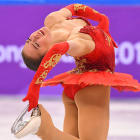
Most who are aware of sports are familiar with the dreaded phenomenon of the "yips," a term to describe when an athlete suddenly and seemingly involuntarily loses what makes them precise and coordinated. In gymnastics, the "yips" are called the "twisties" -- and by nature are extremely dangerous, given what gymnasts do.
They're also a large part of the reason why U.S. gymnastics star Simone Biles has been sidelined from the Tokyo Olympics.
In an Instagram story on Thursday night, Biles answered questions from fans concerning the "twisties," which were a major factor in her withdrawal from the team final and individual all-around at the Olympics. The "twisties" are a state of disassociation affecting gymnasts, leaving them disoriented, unable to coordinate themselves in midair, and at risk for injury.
"It's honestly petrifying trying to do a skill but not having your mind and body in sync. 10/10 do not recommend," Biles wrote. "Literally can not tell up from down. It's the craziest feeling ever. Not having an inch of control over your body. What's even scarier is since I have no idea where I am in the air I also have NO idea how I am going to land. Or what I am going to land on. Head/hands/feet back…"
When she withdrew from competition on Tuesday for what was described as a "mental issue," Biles faced criticism from some who believed that she "quit" on her team in the face of adversity. Biles pushed back against such an idea, claiming that she had removed herself for her personal safety rather than as a reaction to an uncharacteristic performance.
"I didn't have a bad performance and quit. I've had plenty of bad performances throughout my career and finished competition. I simply got so lost my safety was at risk as well as a team medal," Biles said.
This isn't the first time in her career that Biles has experienced the twisties, and her past experiences with it have left her status for next week's series of women's gymnastics individual finals in doubt. Biles shared that in the past, the timeline for her recovery from the twisties has been "usually two or more weeks".
















